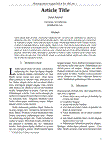CALIDAD BACTERIOLOGICA DE ENSALADAS DE ZANAHORIA RALLADA Y EFICACIA DE TRATAMIENTOS PREVIOS A SU CONSUMO
Introducción: La venta de ensaladas listas para consumir creció en los últimos años. Desde 2012, el Código Alimentario Argentino (CAA), Art. 925 quater, regula la aptitud de las mismas. Objetivo: Evaluar la calidad bacteriológica de ensaladas de zanahoria rallada y estudiar la reducción bacteriana f...
| Autores principales: | , , , |
|---|---|
| Formato: | Artículo |
| Lenguaje: | español |
| Publicado: |
Universidad Autónoma de Nuevo León,Facultad de Salud Pública y Nutrición
2017
|
| Acceso en línea: | https://respyn.uanl.mx/index.php/respyn/article/view/25 |
| Sumario: | Introducción: La venta de ensaladas listas para consumir creció en los últimos años. Desde 2012, el Código Alimentario Argentino (CAA), Art. 925 quater, regula la aptitud de las mismas. Objetivo: Evaluar la calidad bacteriológica de ensaladas de zanahoria rallada y estudiar la reducción bacteriana frente al lavado con agua potable y la desinfección con hipoclorito de sodio y con una solución de vinagre. Métodos: Se analizaron 30 muestras de ensalada de zanahoria rallada y se les aplicaron los tratamientos mencionados, para evaluar las diferencias se realizó una prueba no paramétrica de Friedman. Resultados: El 50% de las muestras no cumplió con el CAA para Escherichia coli. El porcentaje disminuyó al 45 con un lavado previo o tratamiento con vinagre. Entre estos tratamientos no hubo diferencias. La desinfección con hipoclorito aumentó la aptitud un 15% y presentó diferencias altamente significativas con el resto (p < 0.01). Salmonella se encontró en el 7% de las muestras y se eliminó con hipoclorito. E.coli O157 no se detectó. El 100% de las muestras presentaron recuentos de Staphylococcus aureus menores a 2500 UFC.g-1, lo cual no constituiría un riesgo potencial. Discusión: Se destaca la importancia de la calidad microbiológica de la materia prima, dado que el 35% de las muestras no logró la aptitud aun aplicando el tratamiento con hipoclorito. Se plantea la necesidad del rotulado apropiado para evitar dejar librado al criterio del consumidor el manejo del alimento. La implementación de Buenas Prácticas Agrícolas y de Manufactura contribuiría a obtener alimentos inocuos, de mejor calidad microbiológica.ABSTRACTIntroduction: The sale of ready-to-eat salads increased in recent years. Since 2012, the Código Alimentario Argentino (CAA), Art. 925 quater, regulates its microbiological quality. Objective: To evaluate the bacteriological quality of grated carrot and to study the reduction of bacterial counts applying washing with tap water, disinfection with sodium hypochlorite and with a vinegar solution. Methods: Thirty grated carrot samples were analyzed and the above-mentioned treatments were applied. A nonparametric Friedman test was performed to evaluate the differences. Results: 50% of the samples expended did not achieve the requirements of the CAA for Escherichia coli. The percentage dropped to 45 with a previous-wash or treatment with vinegar. No differences were found between these treatments. When disinfection with hypochlorite was done 15% more reached the requirements and this treatment showed highly significant differences with the rest (p < 0,01) .Salmonella was found in 7 % of the samples and were eliminated with hypochlorite. E.coli O157 was not detected. 100% of the samples showed Staphylococcus aureus counts less than 2500 UFC.g-1, which do not constitute a potential risk. Discussion: It should be pointed out the importance of the microbiological quality of raw material, since the 35% of the samples do not reach the requirements even applying the treatment with hypochlorite. Appropriate labeling is necessary to avoid leaving up to consumers criteria the food handling. The implementation of Good Agricultural Practices and Manufacturing would contribute to safe food, and of better microbiological quality.Palabras Clave: vegetales mínimamente procesados; calidad bacteriológica; seguridad alimentaria, : minimally processed vegetables; bacteriological quality; food Safety |
|---|---|
| Descripción Física: | RESPYN Revista Salud Pública y Nutrición; Vol. 16 No. 1 (2017): enero - marzo 2017; 9-15 RESPYN Revista Salud Pública y Nutrición; Vol. 16 Núm. 1 (2017): enero - marzo 2017; 9-15 1870-0160 |
